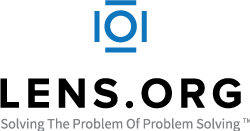The Lens
 | |
Type of site | Patent Search Service |
|---|---|
| Available in | Multilingual |
| Owner | CAMBIA |
| URL | The Lens |
| Commercial | Not for profit |
| Registration | No |
| Launched | 2000 |
| Current status | Active |
The Lens is an online patent search facility and knowledge resource, provided by Cambia, an independent, international non-profit organization dedicated to democratizing innovation. Launched in 2000, the Patent Lens allowed free searching of over 10 million full-text patent documents, including United States patents and applications, Australian patents and applications, European patents and Patent Cooperation Treaty (PCT) applications. The Patent Lens was distinguished as being the only not-for-profit facility of its kind, with international coverage and links to non-patent literature and tutorials.
In 2013 the Patent Lens was officially replaced with Cambia's new site The Lens. The Lens made improvements in the visual presentation of patent analysis and workspace management. It also features a biological facility with a number of advanced tools for searching and analysing sequences found in patents.
Features
Searches of the Lens can be undertaken using numerous variables, including full-text, title, abstract, inventor, applicant/assignee, publication number and filing number. A user is also able to search for lapsed, abandoned, or expired US patents via the INPADOC patent status and family information service. Patent families may be visualized using graphical trees as pdfs.
The Lens currently links to regulatory data in the form of the United States Food and Drug Administration (FDA) Orange Book: Approved Drug Products with Therapeutic Equivalence Evaluations.[2] Biological sequence data is integrated via links to National Center for Biotechnology Information (NCBI) GenBank and the Patent Lens's own gene sequences. The Patent Lens Sequence Project,[3] commenced in June 2006, provides the only public facility to enable users to explore over 80 million DNA and protein sequences disclosed in patents.[4]
Patent tutorials[5] are available on the site covering patent claims, freedom to operate, patent inventorship, and continuing patent applications. Plant breeders' rights (PBR), also known as plant variety rights (PVR), are also addressed. This has the intention to 'forge a learning resource that participants in innovation systems at all levels... can use to learn of critical and timely issues relevant to improving the public good... by engaging with the patent system.'[6]
Native language support
The patent search interface is available in Chinese, English and French, with the full text of European Patent Office (EPO) patents being searchable in English, French and German. PCT applications are searchable in Chinese, English, French, German, Japanese, Korean, Russian and Spanish.
Technology landscapes
In addition to the patent search engine, the Lens also hosts a number of “technology landscapes”.[7] These landscapes serve as interpretation maps that analyze volumes of specialized patent, scientific, technical and business data around particular topics into a more navigable form.
In the field of health and medicine, landscapes have been created for human genome patenting, the influenza genome, the human Telomerase gene, molecular markers outside gene sequences, and adjuvants. For agriculture and the environment, landscapes exist to describe the Agrobacterium-mediated transformation of plants, promoters used to regulate gene expression, antibiotic resistance genes and their uses in plant genetic transformation, resistance to Phosphinothricin, positive selection, bioindicators/ambiosensors, and the rice genome.
From 2000-2004, the Rockefeller Foundation backed development of the initial technology landscapes. In 2005, the Patent Lens made the landscapes fully navigable, interactive, and updatable by users.
Endorsement
The landscaping activities of the Patent Lens have been endorsed by Dr. Francis Gurry, director general of the World Intellectual Property Organization (WIPO) in March, 2009, in 'view of the shared objective of making patent information systems more comprehensive and accessible, and turning raw patent data into useful information resources so as to strengthen the empirical basis of international policy processes.'[8]
Nature Biotechnology has called the Patent Lens 'a giant leap in the right direction' for providing researchers, technology transfer offices and company executives a facile means of establishing the novelty of their offerings and the nature of their competitors' inventions.[9]
See also
References
- ^ "Patentlens.net Site Info". Alexa Internet. Retrieved 2014-04-01.
- ^ "United States Food and Drug Administration Orange Book: Approved Drug Products with Therapeutic Equivalence Evaluations". Retrieved 2010-01-04.
- ^ "Cambia's Sequence Project". Retrieved 2010-01-04.
- ^ Connett Porceddu, MB, Bacon, N, Ashton, D, Baillie, B, dos Remedios, N, Wei, Y, Jefferson, RA (2007). "Constructive approaches to Intellectual Property Complexity in Today's Agricultural Technology World" (PDF). Plant Molecular Breeding. 5 (2): 294–295.
{{cite journal}}: CS1 maint: multiple names: authors list (link) - ^ "Patent Tutorials and FAQs". Retrieved 2010-01-04.
- ^ Jefferson, Richard (Fall 2006). "Science as Social Enterprise: The CAMBIA BiOS Initiative" (PDF). Innovations. 1 (4): 13–44. doi:10.1162/itgg.2006.1.4.13. Archived from the original (PDF) on 2011-01-24. Retrieved 2010-01-06.
- ^ "Patent Lens Technology Landscapes". Retrieved 2010-01-04.
- ^ "Patent Lens Letter of Endorsement from Dr. Francis Gurry, Director General, World Intellectual Property Organization (WIPO)" (PDF). Archived from the original (PDF) on 2009-10-24. Retrieved 2010-01-04.
- ^ "Patently Transparent". Nature Biotechnology. 24 (5): 474. 2006. doi:10.1038/nbt0506-474a. PMID 16680110.
